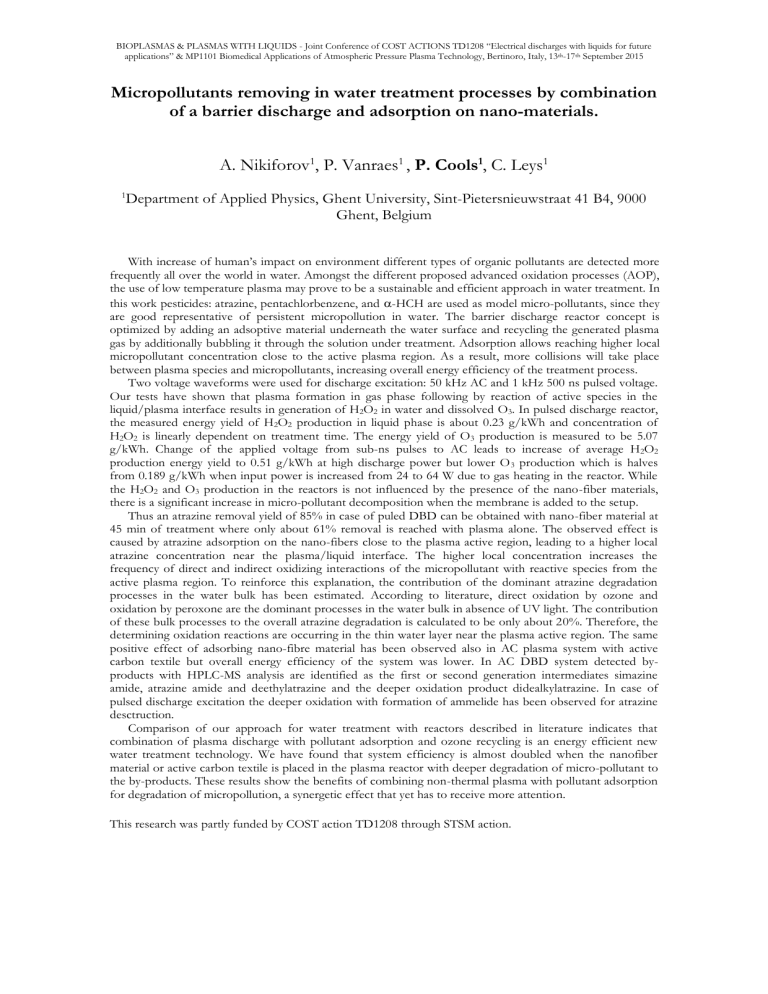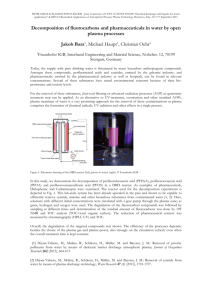P. Cools 1 - Bioplasmas and Plasmas with Liquids

BIOPLASMAS & PLASMAS WITH LIQUIDS - Joint Conference of COST ACTIONS TD1208 “Electrical discharges with liquids for future applications” & MP1101 Biomedical Applications of Atmospheric Pressure Plasma Technology, Bertinoro, Italy, 13 th -17 th September 2015
Micropollutants removing in water treatment processes by combination
of a barrier discharge and adsorption on nano-materials.
A. Nikiforov
1
, P. Vanraes
1
, P. Cools
1
, C. Leys
1
1
Department of Applied Physics, Ghent University, Sint-Pietersnieuwstraat 41 B4, 9000
Ghent, Belgium
With increase of human’s impact on environment different types of organic pollutants are detected more frequently all over the world in water. Amongst the different proposed advanced oxidation processes (AOP), the use of low temperature plasma may prove to be a sustainable and efficient approach in water treatment. In this work pesticides: atrazine, pentachlorbenzene, and -HCH are used as model micro-pollutants, since they are good representative of persistent micropollution in water. The barrier discharge reactor concept is optimized by adding an adsoptive material underneath the water surface and recycling the generated plasma gas by additionally bubbling it through the solution under treatment. Adsorption allows reaching higher local micropollutant concentration close to the active plasma region. As a result, more collisions will take place between plasma species and micropollutants, increasing overall energy efficiency of the treatment process.
Two voltage waveforms were used for discharge excitation: 50 kHz AC and 1 kHz 500 ns pulsed voltage.
Our tests have shown that plasma formation in gas phase following by reaction of active species in the liquid/plasma interface results in generation of H
2
O
2
in water and dissolved O the measured energy yield of H
H
2
O
2
2
O
2
is linearly dependent on treatment time. The energy yield of O
3
. In pulsed discharge reactor,
production in liquid phase is about 0.23 g/kWh and concentration of
3
production is measured to be 5.07 g/kWh. Change of the applied voltage from sub-ns pulses to AC leads to increase of average H
2 production energy yield to 0.51 g/kWh at high discharge power but lower O from 0.189 g/kWh when input power is increased from 24 to 64 W due to gas heating in the reactor. While the H
2
3
O
2
production which is halves
O
2
and O
3
production in the reactors is not influenced by the presence of the nano-fiber materials, there is a significant increase in micro-pollutant decomposition when the membrane is added to the setup.
Thus an atrazine removal yield of 85% in case of puled DBD can be obtained with nano-fiber material at
45 min of treatment where only about 61% removal is reached with plasma alone. The observed effect is caused by atrazine adsorption on the nano-fibers close to the plasma active region, leading to a higher local atrazine concentration near the plasma/liquid interface. The higher local concentration increases the frequency of direct and indirect oxidizing interactions of the micropollutant with reactive species from the active plasma region. To reinforce this explanation, the contribution of the dominant atrazine degradation processes in the water bulk has been estimated. According to literature, direct oxidation by ozone and oxidation by peroxone are the dominant processes in the water bulk in absence of UV light. The contribution of these bulk processes to the overall atrazine degradation is calculated to be only about 20%. Therefore, the determining oxidation reactions are occurring in the thin water layer near the plasma active region. The same positive effect of adsorbing nano-fibre material has been observed also in AC plasma system with active carbon textile but overall energy efficiency of the system was lower. In AC DBD system detected byproducts with HPLC-MS analysis are identified as the first or second generation intermediates simazine amide, atrazine amide and deethylatrazine and the deeper oxidation product didealkylatrazine. In case of pulsed discharge excitation the deeper oxidation with formation of ammelide has been observed for atrazine desctruction.
Comparison of our approach for water treatment with reactors described in literature indicates that combination of plasma discharge with pollutant adsorption and ozone recycling is an energy efficient new water treatment technology. We have found that system efficiency is almost doubled when the nanofiber material or active carbon textile is placed in the plasma reactor with deeper degradation of micro-pollutant to the by-products. These results show the benefits of combining non-thermal plasma with pollutant adsorption for degradation of micropollution, a synergetic effect that yet has to receive more attention.
This research was partly funded by COST action TD1208 through STSM action.







